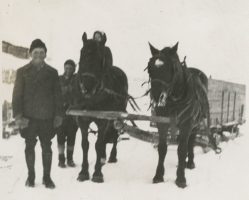By Cecil Moffatt – Regina, Sask.
After two years in the reserve army unit, I stepped forward and volunteered for active duty on July 10, 1941. A full medical and service registration came next. I was issued a full kit and put on a train to Regina. We were immediately put on rifle drills, followed by guard duty. I welcomed guard duty because it kept me from kitchen and other nasty duties!
Ten of us were selected for Non-Commissioned Officer (NCO) training in Dundurn, Sask. This was the beginning of further training in various locations in Canada. Being sent to Lac Megantic, Que., meant more infantry training and spending time clearing among the cottages of Lac Megantic in two to three feet of snow.
Sometimes we had snowshoes or skis. There was much chatter among the boys and many said, “They must be sending us to Norway!”
I received artillery and driver training in gun tractor trucks in the Fort Gary part of Winnipeg. It was very cold, 32° to 40° F below zero. After nine days of a 14 day leave, a call came to proceed to Nanaimo, B.C. for small arms training.
City was blacked out
Because of reports that a Japanese sub had fired on a lighthouse on the tip of Vancouver Island, the city was blacked out and 25 men were on guard duty every night. Meanwhile, Moosomin Battery 101 was up to strength and moved to Sussex, N.B., where it was designated as a Light Anti-Aircraft Battery. It was equipped with 40mm Bofor guns rather than 25 pound field guns.
After training on wooden makeshift guns and embarkation leave, I was sent to Halifax and put on the ship “Capetown Castle”. It was a cattle boat but suitable and fast. The trip across the ocean was uneventful until we came to the rough Irish Sea. Many of us prairie land-lubbers had cause to fear for our dinner!
Some of the ships slipped away to their ports, but soon with the sun shining on the silver balloons, spit-fires came out of the clouds to welcome us and the red brick buildings of Liverpool, England came into view. This was Aug. 17, 1942.
Our new camp was Colchester, northeast of London. New training started including a new NCO course. We received equipment for route marches, schemes, physical training (PT), and new guns for anti-aircraft training.
Our first real action came when we were stationed along the English Channel. If we heard a Doodle-Bug coming over the channel with no fighter plane on its tail, it was our game.
High ranks in casual dress
Just prior to D-Day, the Battery’s 18 guns were deployed around the headquarters of General D.D. Eisenhower, Field Marshall Bernard Montgomery, and Admiral Earl Mountbatten. They often took walks past my gun position in casual dress, except for the Admiral who was always in naval dress.
Following protection duty at the Port of Portsmouth, my unit moved to London to begin our journey by boat to Courseulles, France. Then came the Falaise Pocket. The enemy’s 7th Army was surrounded, prisoners were taken, their equipment was dispensed with and soon, we were on the move again.
After Falaise there was little enemy resistance. We travelled in convoy only stopping for a few pockets of resistance. Because of a lack of petrol, the enemy was using hundreds of horses to pull their heavy equipment. Their retreat was slow and often stragglers were left behind.
We once came upon two trailers of frozen tomatoes and thought they would be a treat, only to find they were too acidic and could only be used in soup. Days later, we found another small trailer of beautiful Java cigars, likely from officers’ supplies. This one was booby-trapped though. After successfully detonating the explosives, we salvaged enough cigars to fill a barrack box in the truck and we smoked those Java cigars across Europe.
More obstacles before making it home
The next obstacles were the Seine and Rhine Rivers, along with a few canals. The battery was near Oldenburg, about 40 kilometres west of Bremen, Germany, on VE Day.
I had the pleasure of returning to North America aboard the Queen Elizabeth II. We pulled into New York shortly after Christmas. While on the ship, we were served a full Christmas dinner, just like back home. I stepped off the train in Regina, New Year’s Eve, 1945 just as the crowd was singing Auld Lang Syne.



